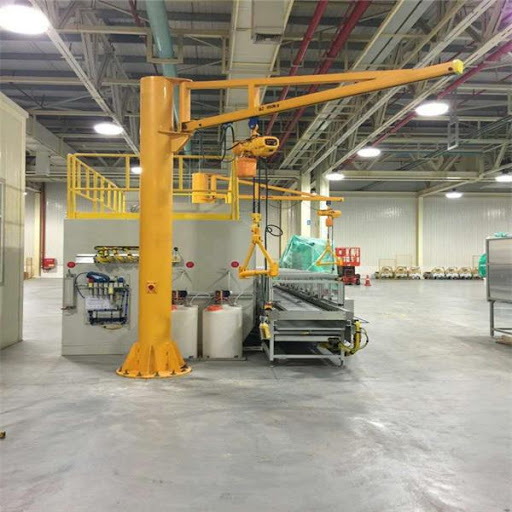2 Ton Floor Mounted Jib Crane
Floor mounted jib crane is a mechanical equipment used for cargo handling and lifting. It usually consists of a column-supported jib, lifting mechanism and control system. The base of the jib crane is installed directly on the ground, so it is called a floor-standing type. This type of jib crane is often used in factories, warehouses, processing workshops and other places to lift and carry heavy objects to improve logistics efficiency and work safety. Floor mounted jib cranes can usually rotate 360 degrees and can flexibly cover a large working range.
Floor mounted jib crane mainly uses a combination of rotating arm and telescopic arm to hoist and carry items. By controlling the length and angle of rotation of the swing and telescopic arms, operators can easily move items to the desired location. This type of crane is often equipped with an electric hoist or hydraulic system for more efficient and safer handling of items.

Introduction to composition structure:
● Column: It is the main support structure of the jib crane. It is connected to the base and supports the jib and lifting mechanism of the crane. Columns are usually strong and rigid enough to bear the weight of the jib and hoisting mechanism as well as the weight of the cargo being hoisted.
● Rotating mechanism: The rotating arm can rotate 360 degrees in the horizontal direction to facilitate the adjustment and positioning of the lifting object.
● Boom: It is the main lifting part of the jib crane. It is usually composed of a steel structure and has sufficient strength and rigidity to withstand the load of the lifting object.
● Lifting mechanism: including hooks, ropes, electric hoists, etc., used to lift and lower lifting objects, and is usually driven by an electric motor or hydraulic system.
● Control system: used to operate and control the lifting actions of the jib crane, including lifting, lowering, rotating and other functions.
Power supply system: Jib cranes usually require power to drive their lifting mechanisms and control systems, so they need to be equipped with corresponding power systems, such as cables, sockets, etc.
Applicable scene:
1. Factory workshop: hoisting and carrying various heavy items, such as machine parts, raw materials, etc.
2. Logistics warehouse: moving items from one place to another to improve warehouse management efficiency.
3. Construction sites: hoist construction materials, equipment and other heavy items to reduce the labor intensity of workers.
4. Port terminal: hoisting and handling various large items, such as containers, ships, etc.

Product advantages:
● The structure is relatively simple and has higher reliability and durability.
● It is easy to operate. The operator can control the rotation, lifting and movement of the crane through the console or remote control.
● It is relatively flexible in terms of space utilization and is suitable for work sites of various shapes and sizes.
● It is equipped with advanced control systems and safety protection devices, which can effectively avoid operating accidents.
● It has low installation and maintenance costs, and at the same time has high efficiency and flexibility in various lifting tasks, so it has advantages in cost-effectiveness.
